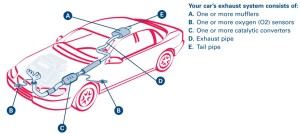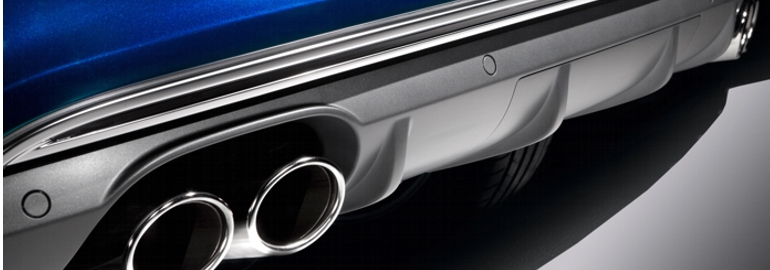Mufflers & Exhaust System Repair
Long Beach, CA
Exhaust System – Muffler – Catalytic Converter
The most obvious sign of a problem with your car’s exhaust system or muffler is a deep or loud rumbling sound coming from your car.
Don’t delay in getting exhaust problems and exhaust noises repairs. Doing that could lead to more costly and avoidable repairs. That’s because driving with an exhaust leak or bad catalytic converter can damage other things in your vehicle’s operating system.
Exhaust systems are a lot more than just mufflers. On today’s vehicles, the exhaust system has three main functions. They are:
- Safely move the exhaust gasses from the engine out through the tailpipe
- Reduce or muffle the noise created by the combustion of fuel
- Trap and remove harmful pollutants from your car’s exhaust emissions
It’s important to understand that exhaust gases are poisonous and contain carbon monoxide. Carbon monoxide can be deadly.
For that reason, it’s critically important that the exhaust gases do not enter the passenger compartment of your car. Exhaust system leaks could lead to escaping exhaust gases entering the passenger compartment – and that could make you sick or kill you.
If you have the smell of exhaust in your vehicle or suspect an exhaust system leak, roll your windows down while driving and get your vehicle checked.
It’s also important to know that sometimes the sound from an exhaust leak is loud and obvious. On the other hand, an exhaust leak could be a simple ticking sound when you start the engine that goes away as you drive. That ‘ticking’ sound could be the signs of an exhaust leak that is just a small crack or a bad fitting or gasket that leaks when it’s cold – but seals up when the metal heats and expands.
Your Car’s Exhaust System Components

Your Car’s Exhaust System – showing mufflers, O2 sensors, catalytic converters, exhaust pipe and tail pipe
The Catalytic Converter
The Catalytic converter is sometimes confused with the muffler. Like mufflers, catalytic converters wear out and require replacement. They’re expensive and for that reason, you should take the steps to help make them last as long as possible. You can do that by keeping your car’s fuel system clean and maintaining a clean air filter.
The catalytic converter is one of the highest priced parts of your car’s exhaust system. In some cases, when the catalytic converter fails, it may sound like someone shaking a box of rocks when your vehicle is idling, parked or stopped in traffic. If you notice any of these sounds, it’s a good idea to schedule an appointment for an exhaust system inspection.
The Muffler
The function of the muffler is really quite simple. They are designed to reduce the noise of the engine and sounds of combustion.
Inside a muffler, there’s a simple set of tubes with holes. These tubes and chambers are designed to cancel out the sound waves produced by the engine, keeping your car quiet.
Although mufflers are designed in a variety of ways – some provide more of a roar or rumble – while others that maintain a whisper quiet exhaust.
Other visitors looking at Exhaust System Repair also wanted to…
Book An AppointmentGet CouponsFind Us Fast Ask A MechanicSee Our Auto ServicesRead Customer ReviewsSmoke coming from your car’s tailpipe?
Do you have smoke coming from your car’s exhaust?
Typically, if you can see smoke coming from your car’s tailpipe, it’s an indication that there are problems with your engine. It doesn’t necessarily mean you need to replace your engine, but to determine the cause, you need to consider the color of the smoke.
There are three common colors of smoke that come from car tailpipes. They are white smoke, white smoke, blue smoke and black smoke.
White Smoke from your car’s tailpipe:
Usually this is caused by water or antifreeze. In reality, the white smoke is actually steam. The steam or white smoke is created because your car’s engine is burning coolant.
The most common problem stems from leaks in the cylinder head gaskets – often called head gaskets. Head gaskets seal the cylinder head where it attaches to the engine body. The gaskets prevent coolant or antifreeze from entering the combustion chamber where fuel and air mixture is compressed and burnt.
Any amount of antifreeze that enters the cylinder will produce the white smoke or steam that you see coming from the tailpipe area.
What should you check if you see white smoke coming from the tailpipe?
The first check would be to see if there is the correct amount of coolant or antifreeze inside the radiator overflow. Check carefully to see if the antifreeze is contaminated with engine oil .
Next, check the engine dipstick for any signs of the oil being contaminated with antifreeze. Additionally, check the underside of oil fill cap. When oil is contaminated with antifreeze, the color of the oil will be similar to a chocolate milkshake.
If your car’s engine oil is contaminated, do not start the engine. There is most likely serious internal engine damage – and operating the engine could make it worse.
How does antifreeze or coolant get into the engine oil? This usually occurs as a result of the engine being overheated. Excess heat causes the head gasket to fail. That allows the coolant or antifreeze to enter the combustion chamber (cylinder).
Blue smoke coming from your car’s tailpipe
Blue smoke is an indication that engine oil is being burnt along with the fuel and air mixture (in the engine’s cylinders) This is more likely to occur in older vehicles with higher mileage.
How did the engine oil get inside the cylinder in the first place? The vehicle engine has many seals and gaskets that are designed to keep the oil from entering the cylinders.
The blue smoke coming from your car’s tailpipe is an indication that one or more of those seals or gaskets has failed.
Excess amounts of oil being burnt in the cylinders will cause the spark plugs to foul. When spark plugs foul, your engine starts to misfire. (Often called an engine miss)
Black smoke coming from your car’s tailpipe:
Black smoke is an indication of excess fuel entering the cylinder. Because the air/fuel mixture is critical to efficient combustion, the excess fuel cannot be burnt.
This condition is often referred to as ‘running rich’. This condition can cause poor fuel economy (bad gas mileage), poor engine performance and produce an odor of fuel.
How did the fuel get into the cylinder in the first place? On older vehicles using a carburetor, the carburetor is out of adjustment. Other causes for excess fuel or ‘running rich’ could be a faulty fuel pump, a leaky fuel injector, or a faulty engine computer or computer sensor.
If you have black smoke from your car’s tailpipe, check the engine oil and make sure excess fuel has not contaminated the oil. In the case of fuel contamination, there will be a distinct odor of raw fuel in the engine oil.
In either of the cases listed above, the smoke from your tailpipe should not be ignored. Contact us or book your next service appointment to determine the reason why smoke is coming from your tailpipe.
Other visitors wanted to…
Book An AppointmentGet CouponsFind Us Fast Ask A MechanicSee Our Auto ServicesRead Customer Reviews



